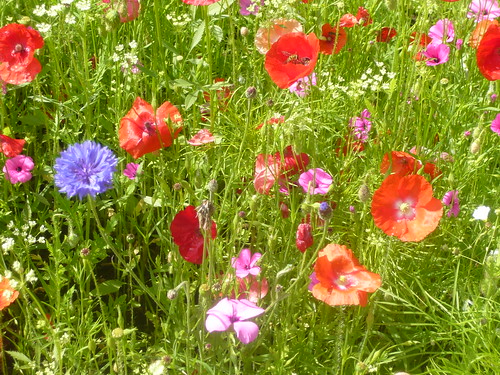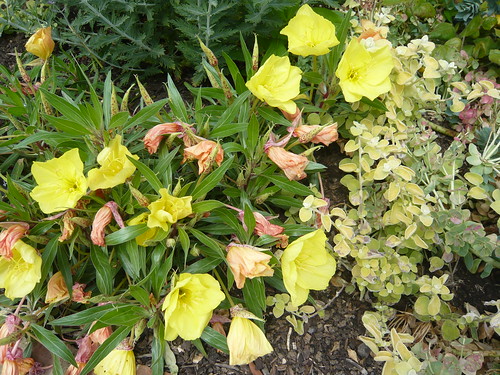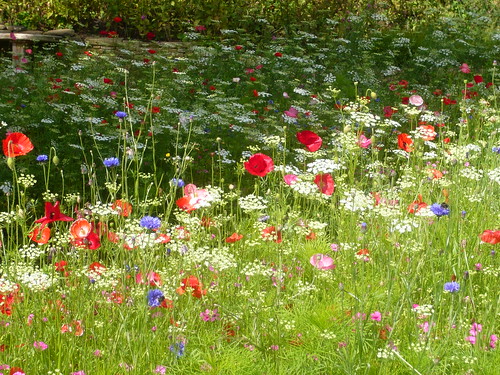Scented Wild Flowers by Family
Opium may be a perfume that owes it’s history derived from wild poppies.

Masses of wild flowers can produce a scented atmosphere that is second to none. Many plant families have scented species so sniff out your favourite.
Explanation why Wild Flowers are Scented
- Scent is the oxidisation of essential oils of flowers and leaves.
- Oils are mainly found on the upper surface of petals.
- The most scented flowers are those with thick velvet like petals which slow down the evaporation of the scent.
- Double white flowers like the rose are especially fragrant.
- Oils are produced in inverse proportion to colour pigment which is why orange and scarlet flowers tend to have less scent.
- Scent is classified into 10 and more groupings.
Examples of Scented Wild Flowers
- Buttercup: Stinking Hellebore is sulphury smelling, Aquilegia vulgaris have a soft clove like scent (without scent in blue and purple varieties) and Clematis vitalba or Old Man’s Beard has a light scent.
- Cabbage: Stinkweed smells when bruised, Sweet Alyssum and Wallflowers are well known for their scent. Hesperis and Matthoila are also native plants to smell out for.
- Hypericum: All the St Johns Wort family have a foxy or goat like smell but Hypericum androsaemum has a more lemony scent.
- Pinks: include the Dianthus and Silene vulgaris or Bladder Campion have the characteristic clove like scent.
- Geranium: Mallows and Laveteria have little or no scent but Geranium robertianum or Herb Robert is quite pungent.
- Rose: Meadow Sweet says it in the name. Wild Strawberry has scented fruit and the drying leaves also produce a good scent. Geum or Wood Avens and Water Avens have scented roots that traditionally add fragrance to apple pie. For Roses go for the field or musk Rosa arvensis, Sweetbriar or Dog Rose Rosa canina. This is a big family and Hawthornes and Mountain ash have a rubber scented flower on a still spring day. Fruit smells come from Pear and Crab Apples.
- Primrose: This family includes Oxlip, Cowslip and Primrose with the cultivated doubles having the strongest scent.
- Honeysuckle: Family has some of the strongest and most pleasent scents from Viburnum, Sambucus (Elder) and Honeysuckle or Woodbine.
- Daisy: Anthemis or Chamomiles have renown scent as have Achillea or Yarrow and Feverfew. The Wormwoods are also part of the Daisy family.
- Lily: Probably takes the prize for the most scented family. From Lily of the Valley (Convalleria majalis), Polygonatum, Fritillary meleagris to Hyacinth, Chives, Scilla and the Turkscap Lily they are all fine scents.
Other Wild Scents of Note
- Violet odorata was Shakespear’s favourite flower judging by the mentions it gets in his plays.
- Evening Primrose Oenothera odorata has become colonised on waste land close to the coast
- Berberis vulgaris has a scent to attract flies whilst its cousin the imported Mahonia has a sweet scent in winter.
- Herbs particularly the Thyme and Parsley family have good scents.
- Many wild Orchids have there own fragrance.
Woodland wild flowers like bluebells and wild garlic and scents to remember
In the UK the Natural History Museum run an excellent service where you can type in your postcode and see which plant species are native to your area, click here to visit it. It includes species they deem as garden worthy.
You can buy seed mixtures aimed at different locations such as Cornfield mix and scented wild flowers from Thompson & Morgan


4 thoughts on “Scented Wild Flowers by Family”
Lovely pictures. I didn’t know that geum roots were edible – I have plenty in my fairly damp garden and could probably sacrifice a few in an experiment..
http://www.best4garden.co.uk/
Comments are closed.